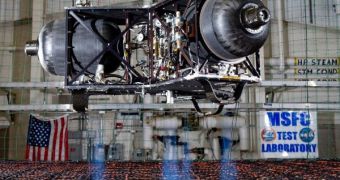The NASA Marshall Space Flight Center is currently taking on a new and difficult task, namely that of producing a lunar lander that is able to, well, land in a place where there is no air. Wings don't do too much good, and propellers are also useless. The only things that could help such a craft safely touch down are its thrusters, according to MSFC engineer Brian Mulac.
“All it takes is practice, practice, practice. And of course, thrusters,” he says. “What we’ve got here is a ‘flying testbed’ to help us to learn how to hover and land on the Moon,” he adds of the robotic lunar lander currently undergoing testing at the Center. Experts from the John Hopkins University (JHU) Applied Physics Laboratory (APL) and the Von Braun Center for Science and Innovation are also involved in the activities, as are other NASA engineers as well.
In the picture, you can clearly see that the thrusters fire up what seems to be a futuristic, pale-blue jet. Mulac explains that this is, in fact, nothing more than average compressed air. “They look blue in this photo because the cold air coming out of the thrusters is interacting with our ‘nice’ Alabama humidity. The plumes are like miniature clouds. They contain ice crystals that scatter blue light,” he adds. One of the thrusters on the spacecraft has enough power to defeat 5/6 of our planet's gravity, with the rest of the nozzles left to fight the remaining one sixth.
This is exactly the same amount of gravitational pull that exists on the Moon, the scientist says. “This prototype’s thrusters are in the same configuration as they would be on the flight robotic lunar lander, so the control algorithms and dynamics are similar,” Project Manager Julie Bassler adds. The MSFC tests are essentially doing nothing more than validate the guidance, navigation, and control systems that are absolutely needed for a safe lunar landing that would not destroy the payloads the lander will carry.
The experts share that the initial tests have been a resounding success. “Once we start a test, it’s all autonomous. An onboard computer directs the thrusters. The flight profile is pre-programmed. We tell the craft where to go and it goes there on its own,” Mulac says. Putting a lander on the Moon “is quite an engineering problem to solve. With our test bed, we’re showing we can do it successfully,” he adds.
“By conducting these tests, we gain an appreciation for the design of missions that land on airless bodies. Many scientifically interesting places in the solar system are airless. Besides the Moon, we’d like to visit Mercury, asteroids, Europa and other airless destinations. What we learn here could have a broad application,” NASA planetary scientist Barbara Cohen concludes, quoted by Space Fellowship.

 14 DAY TRIAL //
14 DAY TRIAL //